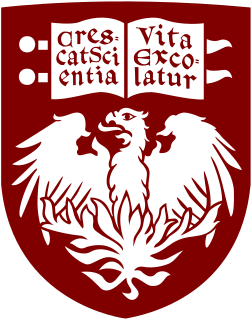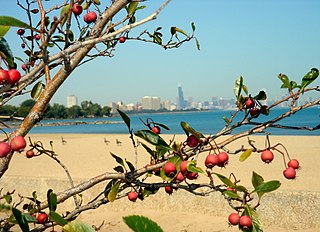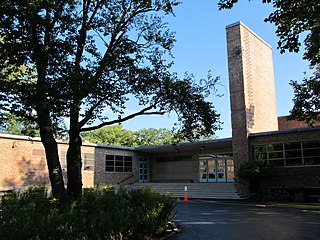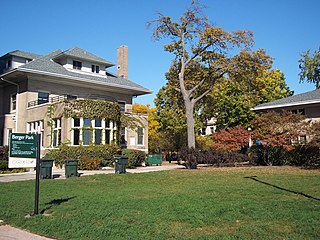
The University of Chicago is a private research university in Chicago, Illinois. Founded in 1890, its main campus is located in Chicago's Hyde Park neighborhood. It enrolled 16,445 students in Fall 2019, including 6,286 undergraduates and 10,159 graduate students. The University of Chicago is ranked among the top universities in the world by major education publications, and it is among the most selective in the United States.

Illinois Institute of Technology is a private research university in Chicago, Illinois. Tracing its history to 1890, the present name was adopted upon the merger of the Armour Institute and Lewis Institute in 1940. The university has programs in architecture, business, communications, design, engineering, industrial technology, information technology, law, psychology, and science. It is classified among "R2: Doctoral Universities – High research activity".

The University of Illinois at Chicago (UIC) is a public research university in Chicago, Illinois. Its campus is in the Near West Side community area, adjacent to the Chicago Loop. The second campus established under the University of Illinois system, UIC is also the largest university in the Chicago area, having more than 33,000 students enrolled in 16 colleges. It is classified among "R1: Doctoral Universities – Very high research activity".

South Shore is one of 77 defined community areas of Chicago, Illinois, United States. A predominantly African-American neighborhood on the city's South Side, the area is named for its location along the city's southern lakefront. Although South Shore has seen a greater than 40% decrease in residents since Chicago's population peaked in the 1950s, the area remains one of the most densely populated neighborhoods on the South Side. The community benefits from its location along the waterfront, its accessibility to Lake Shore Drive, and its proximity to major institutions and attractions such as the University of Chicago, the Museum of Science and Industry, and Jackson Park.

Lower West Side is a community area on the West Side of Chicago, Illinois, United States. It is three miles southwest of the Chicago Loop and its main neighborhood is Pilsen. The Heart of Chicago is a neighborhood in the southwest corner of the Lower West Side.

Saint Ignatius College Prep is a selective private, coeducational Jesuit high school located in the Near West Side neighborhood of Chicago, Illinois. The school was founded in Chicago in 1869 by Fr. Arnold Damen, S.J., a Dutch missionary to the United States. The school is coeducational, Catholic, college preparatory, and sponsored by the Society of Jesus.

Chatham is one of the 77 community areas of the city of Chicago, Illinois. It is located on the city's South Side. It includes the neighborhoods of Chatham-Avalon, Chatham Club, Chesterfield, East Chatham, West Chatham and the northern portion of West Chesterfield. Its residents are predominantly African American, and it is home to former Senator Roland Burris. Housing many city employees and other officials, Chatham has been a central area for Chicago's middle-class African Americans since the late 1950s.

Chicago Public Schools (CPS), officially classified as City of Chicago School District #299 for funding and districting reasons, in Chicago, Illinois, is the third largest school district in the United States. CPS is only smaller than Los Angeles Unified School District and the New York City Public Schools. For the 2019–2020 school year, CPS reported overseeing 642 schools, including 477 elementary schools and 165 high schools; of which 514 were district-run, 118 were charter schools, 9 were contract schools and 1 were SAFE schools. The district serves over 355,000 students.

John Bartram High School is a public secondary school serving neighborhoods of the Southwest Philadelphia area of Philadelphia, Pennsylvania, United States.

Pullman National Monument, also known as The Pullman District and Pullman Historic District, is located in Chicago and was the first model, planned industrial community in the United States. The district had its origins in the manufacturing plans and organization of the Pullman Company, and became one of the most well-known company towns in the United States, as well as the scene of the violent 1894 Pullman strike. It was built for George Pullman as a place to produce the famous Pullman sleeping cars.

Crow Island School in Winnetka, Illinois, is an elementary school operated by Winnetka Public Schools. It significant for its progressive philosophy and its International Style architecture. The design of its building was a collaboration between the Chicago firm of Perkins, Wheeler and Will and Eliel and Eero Saarinen. It currently serves kindergarten through fourth grade students. The school was established in 1940-41. The original jungle gym is located here, having been moved from Horace Mann School in 1940. The school was awarded the Twenty-five Year Award by the American Institute of Architects in 1971. It was declared a National Historic Landmark in 1990. In celebration of the 2018 Illinois Bicentennial, Crow Island School was selected as one of the Illinois 200 Great Places by the American Institute of Architects Illinois component.

Edwin Gilbert Cooley Vocational High School was a public 4–year vocational high school and middle school located in the Old Town neighborhood on the Near North Side of Chicago, Illinois, United States.

John Mercer Langston School is an historic structure located in the Truxton Circle neighborhood in Washington, D.C. The two-story brick building was designed by Appleton P. Clark, Jr. The structure was completed in 1902. It was listed on the National Register of Historic Places in 2013.

Mount Vernon Triangle is a neighborhood and community improvement district in the northwest quadrant of Washington, D.C. Originally a working-class neighborhood established in the 19th century, present-day Mount Vernon Triangle experienced a decline in the mid-20th century as it transitioned from residential to commercial and industrial use. The neighborhood has undergone significant and rapid redevelopment in the 21st century. It now consists mostly of high-rise condominium, apartment and office buildings. Several historic buildings in the neighborhood have been preserved and are listed on the National Register of Historic Places. Mount Vernon Triangle is now considered a good example of urban planning and a walkable neighborhood.

Berger Park, officially Park #1255 of the Chicago Park District, is a small recreational area bordering Lake Michigan in the Edgewater neighborhood of North Side, Chicago, Illinois. The park features the historic Downey House and Samuel H. Gunder houses.

Lucy Flower Technical High School for Girls is a historic school building at 3545 W. Fulton Boulevard in the East Garfield Park neighborhood of Chicago, Illinois. It was built in 1927 as a larger home for the school of the same name, which was founded in 1911. Named for Lucy Flower, the school was the only all-female public high school in Chicago. Intended to parallel all-male schools such as Lane Tech and Crane Tech, Flower Tech combined vocational training and home economics in its curriculum. John C. Christensen, the Chicago Board of Education's chief architect, designed the school in the Collegiate Gothic style; inspired by English schools such as the University of Cambridge and University of Oxford, the style was a popular choice for schools at the time.

The Elizabeth Peabody School is a historic school building at 1444 W. Augusta Boulevard in the West Town neighborhood of Chicago, Illinois. The school opened in 1894 to serve the growing number of students in West Town, as immigration and changes to education laws had led to overcrowding at other neighborhood schools. W. August Fiedler, the chief architect of the Chicago Board of Education, designed the school. His design, one of his first after becoming chief architect, combines the utilitarian form of standardized Chicago school designs of the 1870s with elements of the Queen Anne and Richardsonian Romanesque styles. The school served students continuously from its opening until it closed in 2013.

The West Pullman Elementary School is a historic school building at 11941 S. Parnell Avenue in the West Pullman neighborhood of Chicago, Illinois. The school was built in 1894 to support the growing neighborhood; while West Pullman was not the most populous neighborhood in need of a new school, its land had been donated to the school district, reducing the school's cost enough for it to be feasible. School board architect W. August Fiedler designed the Romanesque Revival school, which features a red brick exterior, rounded arched windows, and ornamental brickwork. A 1900 addition to the school doubled its capacity; William Bryce Mundie, the architect for the addition, introduced Classical Revival elements such as terra cotta decorations and a bracketed cornice. A third addition in 1923, designed by John C. Christensen, largely matched the design of the original two sections. The school served students in West Pullman until it closed in 2013 as part of a wave of Chicago public school closings.

James Stephen was an American architect. He was the premier school architect in Western Washington state in the early 1900s. Originally working with wood frame buildings, around 1908 he brought more modern and fire-resistive designs to the Seattle area. He, and later with his son, was responsible for the design of at least fifty schools in Washington as well as many other kinds of buildings. At least three of the schools are listed on the National Register of Historic Places.






















